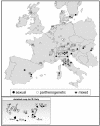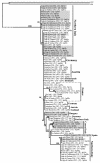Phylogeography of competing sexual and parthenogenetic forms of a freshwater flatworm: patterns and explanations
- PMID: 14622447
- PMCID: PMC280671
- DOI: 10.1186/1471-2148-3-23
Phylogeography of competing sexual and parthenogenetic forms of a freshwater flatworm: patterns and explanations
Abstract
Background: Models of the maintenance of sex predict that one reproductive strategy, sexual or parthenogenetic, should outcompete the other. Distribution patterns may reflect the outcome of this competition as well as the effect of chance and historical events. We review the distribution data of sexual and parthenogenetic biotypes of the planarian Schmidtea polychroa.
Results: S. polychroa lives in allopatry or sympatry across Europe except for Central and North-Western Europe, where sexual individuals have never been reported. A phylogenetic relationship between 36 populations based on a 385 bp fragment of the mitochondrial cytochrome oxidase I gene revealed that haplotypes were often similar over large geographic distances. In North Italian lakes, however, diversity was extreme, with sequence differences of up to 5% within the same lake in both sexuals and parthenogens. Mixed populations showed "endemic" parthenogenetic lineages that presumably originated from coexisting sexuals, and distantly related ones that probably result from colonization by parthenogens independent from sexuals.
Conclusions: Parthenogens originated repeatedly from sexuals, mainly in Italy, but the same may apply to other Mediterranean regions (Spain, Greece). The degree of divergence between populations suggests that S. polychroa survived the ice ages in separate ice-free areas in Central, Eastern and Southern Europe and re-colonised Europe after the retreat of the major glaciers. Combining these results with those based on nuclear markers, the data suggest that repeated hybridisation between sexuals and parthenogenetic lineages in mixed populations maintains high levels of genetic diversity in parthenogens. This can explain why parthenogens persist in populations that were originally sexual. Exclusive parthenogenesis in central and western populations suggests better colonisation capacity, possibly because of inbreeding costs as well as hybridisation of sexuals with parthenogens.
Figures



References
-
- Case TJ, Taper ML. On the coexistence and evolution of asexual and sexual competitors. Evolution. 1986;40:366–387. - PubMed
-
- Peck JR, Yearsley J, Barreau G. The maintenance of sexual reproduction in a structured population. Proc R Soc Lond B Biol Sci. 1999;266:1857–1863. doi: 10.1098/rspb.1999.0857. - DOI
-
- Chaplin JA. The local displacement of a sexually reproducing ostracod by a conspecific parthenogen. Heredity. 1993;71:259–268.
-
- Vandel A. La parthénogenèse géographique: Contribution à l'étude biologique et cytologique de la parthénogenèse naturelle. Bull Biol France Belg. 1928;62:164–281.
-
- Cuellar O. Animal parthenogenesis. Science. 1977;197:837–843. - PubMed
Publication types
MeSH terms
Associated data
- Actions
- Actions

